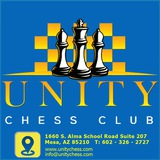40.Nd4 Rxd4 41.Bxd4 Qd6+ 42.Qxd6 Nexd6 43.Be5 Ke6 44.Bxd6 Nxd6 45.bxc4 Nxc4+ 46.Kb4
With play on both flanks. The rook easily outplays the knight, and White wins.
Unity Chess Club
Jan Timman 2610 Anatoly Karpov 2700 London 1984 Black to move
Whatever aggressive move Black makes in the centre, his king will come under a dangerous check. Moreover, if we transfer the move to White, it becomes clear that solving the problem of his own king in the centre will require more than one tempo. This means that it is the ideal time for some useful prophylaxis:
He also loses after 20.Nc5 Bxc5 21.Rxc5 g5 22.Bd2 d5! 23.Qe3 Rhf8, with the threats of 24...Rf5 and 24...Qxh2.
A) 21.Qc2 g5 22.Qxc6+ Bb7 – This is one of the variations where the move 19...Kb7-a8! tells;
B) 21.Qg2 Rxe5+ 22.Bxe5 Bb4+ 23.Kf2 Qxe5 24.Kg1 Rf8 25.Kh2 Qe3–+.
B) 21.Qg2 Rxe5+ 22.Bxe5 Bb4+ 23.Kf2 Qxe5 24.Kg1 Rf8 25.Kh2 Qe3–+.
Unity Chess Club
Ljubomir Ljubojevic 2620 Mikhail Tal 2615 Wijk aan Zee 1976 White to move
In this position, White had a study-like win.
In the game, fearing the strong black passed pawn on c3, White forced a draw: 57.Rb8 Bd6 58.Rd8 Bb4 59.Rb8 draw.
Bad was 57...Bc5 58.Rc7 Bd4 59.Rc4 Be5 60.Ke3+– – the white king helps to hold back the c-pawn.
Other continuations also lose:
A) 58...Bd6 59.Ke2 Kb2 60.Rb7+ Kc3 61.Rb6 Bc5 62.Rc6 Kb4 63.Kd2+–;
B) 58...Bc5 59.Rc7 Bb6 60.a7 Bxc7 61.a8=Q+–.
A) 58...Bd6 59.Ke2 Kb2 60.Rb7+ Kc3 61.Rb6 Bc5 62.Rc6 Kb4 63.Kd2+–;
B) 58...Bc5 59.Rc7 Bb6 60.a7 Bxc7 61.a8=Q+–.
